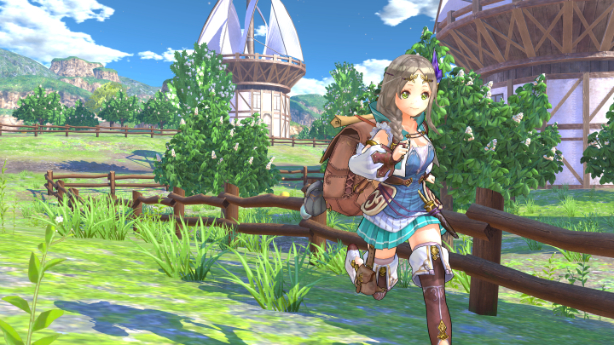The Atelier series has been going for quite a while, from 1997 in fact. The series has focuses on the idea of an Atelier, a private workshop or studio for professional artists. I’ve never really enjoyed many JRPGs, or Japanese games in general. No fault of them, I’m just not a fan. However, the ridiculous fun I am still having with Yakuza 0 has convinced me to keep dipping my toes in the pool and see whether I enjoy it.
Atelier Firis is a JRPG with a lot of mechanics to cover. Alchemy, combat, open world travel, and time limitations are all blended to make a ridiculously charming experience. If you can get behind the idea of essentially playing a game about preparing for an exam, and the rather strange blend of mechanics you will be in for a good time.

Atelier Firis: Alchemist of the Mysterious Journey (Atelier Firis from now on) focuses on the titular Firis, who lives in a quiet little mountain town. The town itself limits its contact with the outer world until the gate of her dear town is blown in by Sophie, the character from the previous game in the series. Seeing how awesome alchemy can be Firis decides that this is her jam and goes on an adventure to become a fully-fledged alchemist, travelling to other cities, applying for the exam and other typical RPG elements.
You can effectively divide Atelier Firis into two parts. Part one is the main bulk of the game story. Firis has a year to reach Reisenberg and take the exam, and a year is plenty of time to do what you need to do if you don’t stray too much. Every action you do will consume time, whether it’s gathering materials, crafting items, battling monsters or even just doting about. You also need to get Firis three letters of recommendation for the exam from certified alchemists. If you don’t goof around too much you should have a good amount of time to do everything you need.

Your payoff for this work is the second half of the game. Once you complete the exam you are free to explore the world at your leisure and helping people who need it and attempting to unlock the multiple game endings. Various open world staples are missing: There is no ultimate goal to accomplish, and you are only given vague hints; the timer is gone and there is no fast travelling. You can now indulge in the alchemy as much as you want to and getting the option to travel the world without the time limit is a welcome addition.
Like any other JRPG there is a host of monsters to defeat. The battle system itself is not special in regards to any other JRPG battle system. You bring three characters into battle, each with a variety of skills. You can use your alchemy items in battle as well which is a nice way of nerfing the tougher enemies. Battles work quickly, with no load times entering a leaving them they feel like the quick experience, and chain attacks and enemy delays means you can unload a lot of damage on the enemy quickly and get back to the story of the game, the more central focus.

The world itself is quite a pleasure to explore. The world is full of quests to complete, items to collect, alchemical ingredients to find and enemies to fight. Most of the actions in the game require LP which needs replenishing by resting at the Atelier or creating items using alchemy to reduce the negative effects of low LP.
Alchemy is one of the biggest mechanics in the game naturally and it is rather engaging, reminiscent of crafting systems in the older Star Ocean games. You create items in cauldrons by following a recipe, throwing in the correct ingredients. You can find recipes around the world, hearing hints from other people and spending ‘Item Points’ to fill out unfinished recipes. You can add catalysts to your ingredients to alter the items as well, adding extra depth. Using catalysts or not the ingredients need to be placed on a grid correctly, with a correct combination allowing addition properties and higher quality results.

On paper the idea is complicated, and if you cannot get your head around it you will not enjoy the game, which goes for the time limit gameplay as well. There are some issues in performance with the framerate dipping on occasion but your biggest bugbears with the game will be if you cannot get behind the mechanics, which can be said for many games.
Apparently the series has yearly releases, and Atelier Firis has convinced me that this is a series of games worth considering. It’s charming, colourful and it’s nice to have a time limit ended and the chance to break off and head off into the big open world. It’s not perfect but it is an enjoyable RPG experience that I will totally get back to and keep playing soon.
The game has just hit the western hemisphere and any fan of JRPGs should give this 7/10 game a good attempt.









You must be logged in to post a comment.